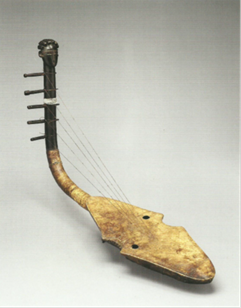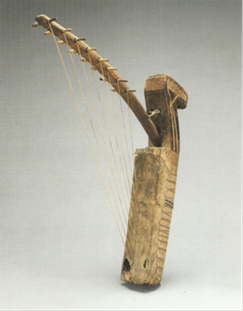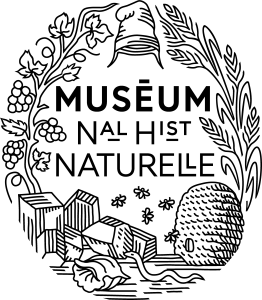What is organology?
Organology or musical instrument science is a discipline which studies musical instruments, their construction, playing methods and their historical development. Organology has a musicology and ethnomusicology component.

Musée royal de l’Afrique centrale, Tervuren, Belgium.
© La parole du fleuve, Harpes d’Afrique centrale, Paris, Cité de la musique, 1999, p.200.
What is the harp made of?
The harp is made up of tight strings between a resonating body and an arched handle. The resonating body is covered with tight snake skin or antelope skin. The skin is tanned or not and sewed on the back of the harps. The skin of the Gabon harps is nailed down the sides. The soundboard is rectangular, triangular, oblong or curved according to the country.
The sound holes are circular or rectangular. The sound holes allow for the best acoustics and changing the strings.
The African harps have 5, 8 or 10 strings. The strings are animal or vegetable. They tie the tailpiece under the soundboard and the handle pegs.
The African harp sculptures are located at the top or at the bottom of the resonating body or on the handle. The sculptures are anthropomorphous.

© La parole du fleuve, Harpes d’Afrique centrale, Paris, Cité de la musique, 1999, p.298.
What is the role of ethnomusicologists?
Ethnomusicologists collect information on the spot with living musicians. They study musical practices in societies in which they are in use. They study the place of music in society. They take into account the circumstances, the functions, the speakers, the musicians, the singers, and the officiants. Ethnomusicologists explore the music and what it represents in this society.
About the collections.
The harps collection at the Musée du Quai Branly comes from the ethnology laboratory at the Musée de l’Homme (9,000 instruments) and comes from the Musée National des Arts d’Afrique et d’Océanie (500 instruments). There are 3,850 African instruments. There are 96 African harps. The instruments are displayed in a glass tower crossing the museum. The instruments are partially visible to visitors.
The harps collection at the Musée royal de l’Afrique centrale is held at the adjacent research centre. A reserve is dedicated to the harps. Only a few harps will be presented at the reopening.
This article was written by Géraldine Robic a Master’s student in the Museum’s “Museology, Sciences, Culture & Societies” specialization.
